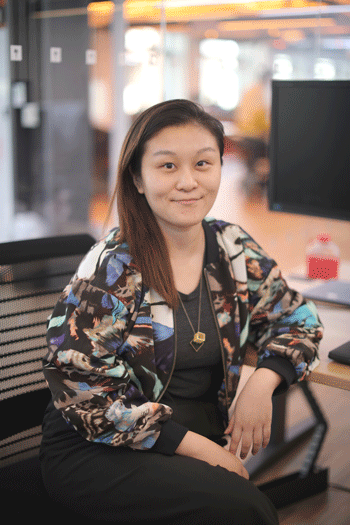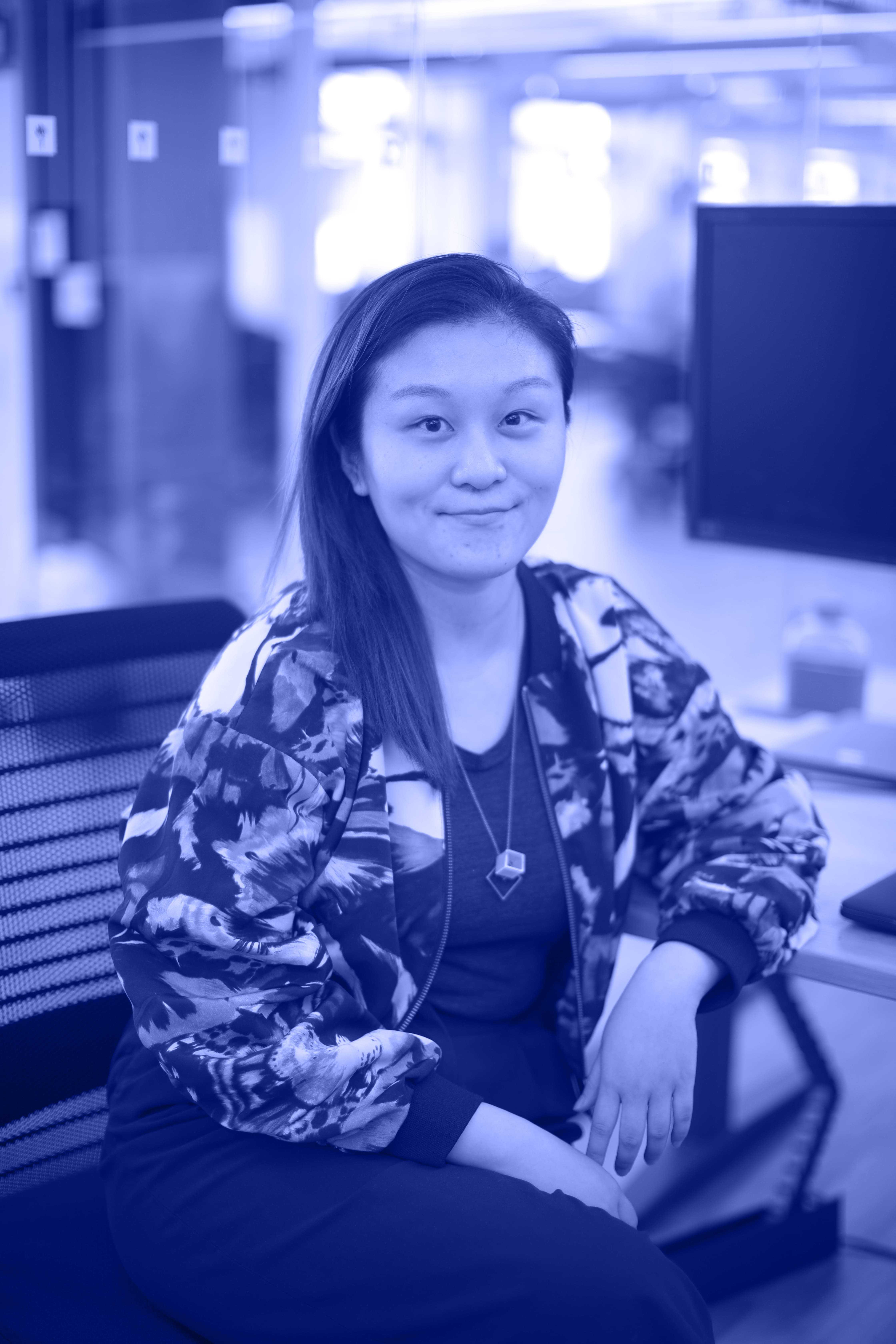 “To become a content generator, a low-level government clerk at the Office of Content Generation involves a long and complex process. One important milestone in the process is the qualification test.” This is the introduction to Carrie Sijia Wang’s performance piece, “The System.”
“To become a content generator, a low-level government clerk at the Office of Content Generation involves a long and complex process. One important milestone in the process is the qualification test.” This is the introduction to Carrie Sijia Wang’s performance piece, “The System.”
In “The System,” Wang sits at a keyboard and types furiously in order to complete “The Content Generator Qualification Test.” The test loops between what Wang refers to as Content Generation, Integration Reinforcement and Subject Realignment.
Content generation demands the subject to type as fast as possible, while Integration Reinforcement calls on them to dictate, aloud, slogans such as “Liberty is a fight to fight because we are all brothers.” Subject Realignment is just that — a reset. The sound of typing creates a modular music composition of monotone, staccato tapping.
Sitting across from me in a coffee shop on West Third Street, Wang herself is rather soft-spoken and reserved, though just as self-possessed as the subject of “The System.”
A recent alumna of the Interactive Telecommunications Program (ITP) at NYU, Wang began work this fall as a resident researcher in the program.
“We spend half our time doing our own projects, research and whatever,” she said. “The other half is devoted to various day-to-day activities, such as workshops for students, TA’ing for professors or helping organize events or shows.”
She’s grateful to have this time to develop her ideas and generate new work. Through her multimedia projects, she meditates on expansive ideas such as consumerism, nationalism, mass surveillance and environmental issues, to name a few.
“People have been talking, especially recently, about how different countries kind of close themselves off and globalism has kind of come to an end, stuff like that,” Wang said, describing the impetus for the creation of “The System.”
“What does a nation mean to individuals?” she asked. “Why do we have to sing national anthems? It’s kind of like people think it’s a given to love your country, but why?”
Her approach to investigating these questions was to compile lyrics from all 204 of the world’s national anthems as the source text for the Integration Reinforcement, as well as text from international tourism websites for the Content Generation portion.
“All of them were official websites, by the government, not just from an agency,” Wang said. “So that’s what the countries want to present to the world. The national anthem is more like what they want their citizens to be proud of.”
The project, for Wang, was not only about nations, but about the ways individuals operate within systems, adhering to a set of “invisible rules” that go unexamined.
She also said that much of her work is informed by her experiences in a strict boarding school in China, in the U.S. immigration system and in the modern office.
“I’m sensitive to rules, regulations and systems,” she said.
As an international student, she had to go through immense amounts of paperwork, switching from a student visa, to a work visa, then back to a student visa. She often had no idea why certain information was required or how it all worked.
The process, for Wang, was not unlike her experience of high school.
“It kind of feels like you’re going round and round in a big machine,” Wang said. “You never really think about why or, like, how does this all relate to me? You just do it.”
And yet it was in that potentially stultifying setting that her passion for the arts blossomed. With limited time and little resources, Wang was always anxious to create. She thinks her interest in the arts was even more persistent in that strict environment than it was in college.
She explained that she went to the School of the Art Institute of Chicago for an abrupt change in her life. Not only was she moving to a new country, but she was starting over in a big city, and what she describes as a particularly American city — at least compared to New York.
She arrived at SAIC intending to study photography and film, before ultimately switching her major to graphic design.
“After a year and a half I was like — well, my parents were like — you will not be able to get a job,” Wang said, laughing. “And I was pretty young and I didn’t know how to survive, so I thought I was not ready to do art as my main career. So I switched to graphic design.”
After graduating, she worked at a design agency in Chicago called UpShift for two years before moving to New York, where she worked at M Moser Associates, an architecture and interior design company.
“I’m interested in office culture and office politics,” Wang said. “I don’t actually play those politics but I like to observe them.”
She declares that she is “inspired by bureaucracy” and the ways in which it changes one’s perspective on the world, and on themselves.
“New York inspired me to look at art again,” Wang said. “That’s why I went to ITP. I knew a few people who went to the program. I found I could do a little bit of everything […] so I thought it was perfect for me.”
Working alongside peers from such a diverse array of artistic backgrounds, from photography to performance to more tech-based fields, Wang was able to discover new avenues through which she could express her ideas as well as gain technical skills that had previously seemed foreign or out of her wheelhouse.
Before ITP, she knew hardly anything about programming, and never imagined she would create her own VR project someday.
Wang’s interactive project, entitled “In Memoriam,” places its two participants in a “surreal world of tree-like structures, open water, and sounds from the past,” according to Wang’s website. Within this virtual reality, they are encouraged to verbalize their observations of their surroundings.
The undisclosed goal of the project is to inspire the two participants — who are unaware that they are in the same virtual reality as the other — within this landscape.
“When we talk about VR, the criticism has been that it kind of blocks you off from reality, communication with real people,” Wang said. “The thought was, what if we can create a VR project that brings people together? And they can explore this new world together while talking, verbally, with each other?”
The project came out of a class she took at ITP called Desert of the Real: Deep Dive into Social VR.
While she’s not the most confident in her programming skills, she credits ITP for exposing her to other students who specialize in technical fields that she’s academically unfamiliar with.
It was at ITP that she learned how to speak the language of the technoverse. She mentioned that a lot of technical terms, such as machine learning, virtual reality, augmented reality and blockchain are thrown around in the media but not ever fully explained.
“I still can’t say I completely understand blockchain,” she laughed.
One of her projects, “Museum of Plastic Age,” was inspired by a trip to The Met.
She took notice of a group on a guided tour through the museum, and began to listen in on the tour leader’s explanations of the meaning behind the various artifacts.
“I heard them saying things like ‘this is a symbol for their God, or this belief, or sex,’ and all of those kind of grand concepts,” Wang said. “When I looked closely, it was just, like, a cup or some container.
“If people in the future look back on our everyday life, would they be assuming that everything has a meaning? There are all these mundane things and when you put them on a pedestal, suddenly they are full of symbolism.”
“Museum of Plastic Age” is an interactive installation which exhibits items from the 21st century in an imagined museum from the future, featuring plastic cups from Starbucks and Cha Cha Matcha represented as potential ritual objects. The installation was first shown at the 2017 ITP Winter Show, and later exhibited at the Ujazdowski Castle Center for Contemporary Art in Warsaw, Poland.
Looking ahead, Wang is working on two projects, both inspired by a “futuristic work environment” in which individuals are constantly observed and evaluated by human resources AI. While she executed a version of this entitled “Alex, Your Best Friend at Work” as her thesis project at ITP, she hopes that with her new project she can take what was a one-sided performance and translate it into a more interactive experience.
The first project is a browser-based storytelling project that engages the participant in an interview with an AI; during the interview, they are able to see the whole office environment in which they would be working.
“The other project is more of an on-site, participatory experience,” she said. It would be presented as a series of installations in which participants would be asked to perform certain tasks or activities.
She imagines one of these installations might be called “work is play.”
In a real-life simulated work environment, participants would be urged to play some innocuous games, all while being ranked against their coworkers by their human resources department.
In another scenario, HR might intervene in a conversation between two colleagues to suggest new topics.
It wouldn’t be the first time Wang examined the role of surveillance in our day-to-day lives.
In her performance piece “Color Censorship,” for example, Wang creates an Orwellian “Office of Stability and Happiness” dedicated to expunging any colors that pose a threat to the mental health of the population. The performer is put in the role of the “moderator” who must delete taboo colors from a screen, according to a series of changing and abstract rules, such as “Saturation fosters immorality.”
In regard to the future, Wang is focused on continuing to create, but she’s also considering teaching.
“I realized I really enjoyed teaching when I was giving workshops and stuff,” she said. “I was always kind of opposed to it because my mom is a professor and I didn’t want to go in the same direction, but I’ve discovered that’s something I would do.”
Wang’s own work still remains her top priority.
“I want to just keep doing my own projects rather than going back to a design agency to do a 9-6 job,” she said.
Of course, the daily grind of an office job can always offer new inspiration.
Email Julie Goldberg at [email protected].
























































































































































